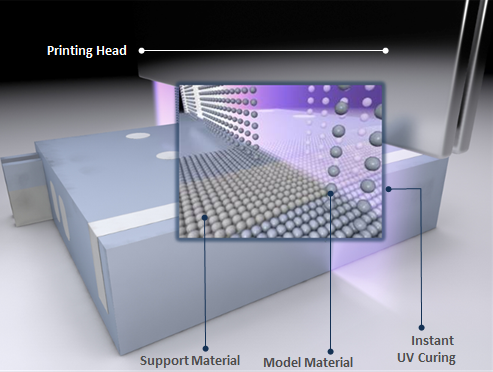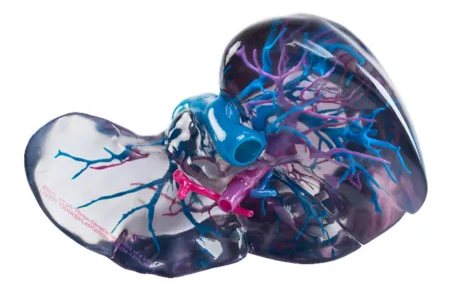
What is Polyjet 3D Printing ?
PolyJet, also known as Photopolymer Jetting, is a 3D printing technology that can be translated as "spraying with UV-curable plastic."
In this process, small amounts of UV- curable material are precisely sprayed onto a build platform.
Unparalleled Precision and Surface Finish. One of the defining features of PolyJet 3D printing is its exceptional surface finish.
Unlike some other 3D printing methods, PolyJet doesn't involve heat, so parts don't shrink during or after production.
This makes PolyJet one of the most precise 3D printing methods available.
How does Polyjet 3D Printing Work?
A 3D model of an object is loaded into a slicing software. The software generates the machine code and divides the object into layers as thin as 0.016 millimeters (16micrometers), also calculating the placement of support material if needed.
The software then sends the final code to the 3D printer. Inside the 3D printer, a cartridge containing a liquid UV-curable material is placed.
The machine pumps this material to the print head. In the PolyJet process, there are typically two print heads, one for the build material and the other for support material.
The build material is heated to around 80°C to make it flowable. Each print head consists of two metal bars, each lined with hundreds of tiny nozzles arranged in a row.
Each nozzle contains a piezo valve. Piezo valves are made of tiny crystals that deform when exposed to an electric current, allowing the nozzle to release the material.
The material, under slight pressure, is dispensed as microdroplets, each containing just a few picoliters (one trillionth of a liter; 0.000 000 000001 liters) of material.
Curing Microdroplets with UV Light
As the print head moves across the length of the build platform, the piezo valve opens at precisely the right moment according to the code, releasing tiny droplets of material.
These droplets are minuscule, measuring only a few micrometers (μ) in diameter, and they are positioned and deposited with incredible precision.
Right behind the print head, there is a roller to smooth the surface.
PolyJet 3D printing can be likened to digital printing on paper. As the print head returns, the layer that has just been deposited is cured by a high-energy UV light source.
This process repeats until the entire object is printed. Removing Support Material with Water Overhangs in PolyJet printing, much like in Fused Deposition Modeling (FDM), require support structures.
In PolyJet, a waxy support material is simultaneously deposited with the build material. To remove this support material, the finished object is placed in a washing station, where the material is rinsed away with a water pressure of 110 bar.


Good to know



Impact of support
It's important to note that the interaction of support structures with the printed object has aesthetic implications. The support structure, when in contact with the model during the printing process, imparts a matte finish to those areas. This means that any part of the object in direct contact with the support structure will exhibit a matte finish.
For those aiming for high-gloss parts, it's vital to strategize the creation of the support structures. Achieving a glossy surface is feasible on the top surface and sidewalls with angles of 90 degrees or less, as these areas are not in direct contact with support structures. To archive a uniform surface on parts that need support, its possible to pack all surfaces in support to generate the same matt finish all around the part.
Multimaterial Printing
PolyJet 3D printing excels in producing multicolored and multimaterial parts, showcasing its versatility in additive manufacturing. By employing multiple print heads, each loaded with different colors or materials, PolyJet enables simultaneous deposition, allowing for vibrant and diverse color schemes, as well as the integration of various materials within a single printed object.
This technology not only enhances the visual appeal of prototypes and end-use parts but also offers the unique capability to mix materials during printing.
this way, polyjet can produce Materials with varying mechanical and visual Propertys such as e.g. shore hardness or opacity within a single print.
Applications
Prototyping Marvels:
PolyJet's capacity for precision makes it an ideal choice for rapid prototyping.
Engineers and designers can swiftly bring their concepts to life, fine-tuning designs and validating ideas with tangible, high-quality prototypes.
Automotive Evolution:
In the automotive industry, PolyJet supports the development of concept cars, functional prototypes, and intricate interior components.
It accelerates innovation and design refinements.
Medical Advancements:
In the medical realm, PolyJet shines brightly. It's utilized to craft anatomical models for surgical planning and medical research.
Due to its unique capability of combining multible Materials, soft and ridgid, into one part it is a ideal choice for Anatomical models involving Softtissue or for see through applications.
These intricate models offer surgeons invaluable insights into complex procedures, ultimately improving patient outcomes.
Educational Toolkits:
PolyJet plays a pivotal role in education, enabling students to explore complex concepts through tangible models.
It empowers the next generation of engineers, designers, and innovators.
Architectural Visualization:
Architects and urban planners harness PolyJet to create intricate, scaled-down architectural models.
These models help visualize and refine building designs with precision.
